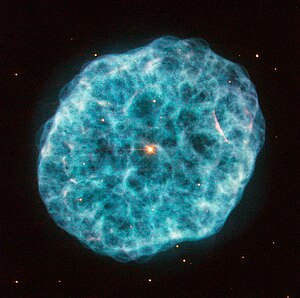NGC 1501
Appearance
| Nebula | |
|---|---|
 As seen from the Hubble Space Telescope | |
| Observation data: J2000 epoch | |
| Right ascension | 04h 06m 59.39s[1] |
| Declination | +60° 55′ 14.4″[1] |
| Distance | est. 4,240 ly (1.30 kpc)[2] ly |
| Apparent magnitude (V) | 13.0[1] |
| Apparent dimensions (V) | 0.863' (diameter) |
| Constellation | Camelopardalis |
| Designations | PK 144+6.1, PN G 144.5+06.5, GC 801, CS 14.4, H 4.53 |

NGC 1501 is a complex planetary nebula located in the constellation of Camelopardalis, discovered in 1787 by William Herschel.[2][3] It is also known as the Oyster Nebula.[4]
References
- ^ a b c "SIMBAD Astronomical Database". NGC 1501. Retrieved 2014-11-09.
- ^ a b Sabbadin, F.; Benetti, S.; Cappellaro, E.; Turatto, M. (2000). "The tetra-lobed planetary nebula NGC 1501". Astronomy and Astrophysics. 361: 1112–1120. arXiv:astro-ph/0007039. Bibcode:2000A&A...361.1112S.
- ^ Seligman, Courtney. "Celestial Atlas: NGC Objects: NGC 1500 - 1549". cseligman.com. Archived from the original on 10 July 2015. Retrieved 10 July 2015.
- ^ "Hubble View of Bubbly Nebula". Retrieved 8 December 2016.
External links
- http://www.astronomy-mall.com/Adventures.In.Deep.Space/abellcat
- http://www.observing.skyhound.com/archives/dec/NGC_1501
